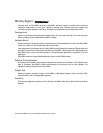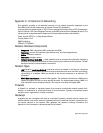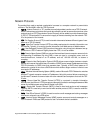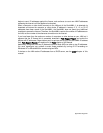Appendices Page 265
IP Addressing
To become part of an IP network, a network device must have an IP address. An IP address is a
unique number that differentiates one device from another on the network to avoid confusion during
communication. To help illustrate IP addresses, the following sections compare an IP address to the
telephone numbering system, a system that is used every day.
Like a phone number with its long distance “1” and area code, an IP address contains a set of four
numbers. While we separate phone number components with dashes, for example 1-408-555-
1212, IP address number components are separated by decimal points or dots (called dotted
decimal notation), for example 123.45.67.89. Because computers use a binary number system,
each number in the set must be less than 255.
There are three components of IP addressing:
• IP address
• Subnet mask
• Default gateway
IP Address
Just as each household or business requires a unique phone number, a networked device (such as
a computer, printer, file server, or router) must have a unique IP address. Unlike phone numbers,
an IP address requires the entire number when communicating with other devices.
There are three classes of IP addresses: A, B, and C. Like a main business phone number that one
can call, and then be transferred through interchange numbers to an individual’s extension number,
the different classes of IP addresses provide for varying levels of “interchanges” or subnetworks,
and “extensions” or device numbers. The classes are based on estimated network size:
• Class A — used for very large networks with hundreds of subnetworks and thousands of devices.
Class A networks use IP addresses between 0.0.0.0 and 127.0.0.0.
• Class B — used for medium to large networks with 10–100 subnetworks and hundreds of de-
vices. Class B networks use IP addresses between 128.0.0.0 and 191.0.0.0.
• Class C — used for small to medium networks, usually with only a few subnetworks and less than
250 devices. Class C networks use IP addresses between 192.0.0.0 and 223.0.0.0.
Just as one would go to the phone company for a phone number, there are controlling bodies for IP
addresses. The overall controlling body for IP addresses worldwide is InterNIC. Businesses or
individuals can request one or many IP addresses from InterNIC. It’s a good idea to estimate the
network’s future growth when requesting the class and number of IP addresses requested.


















